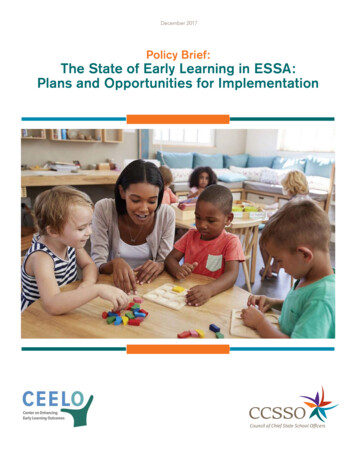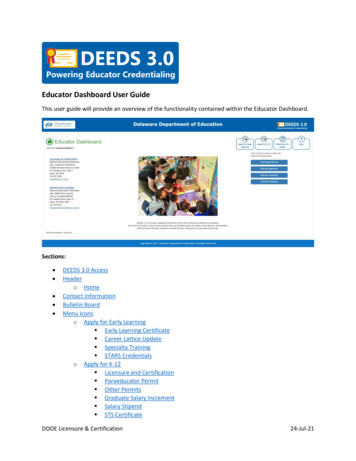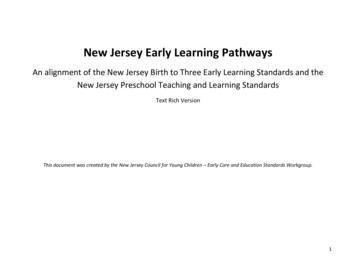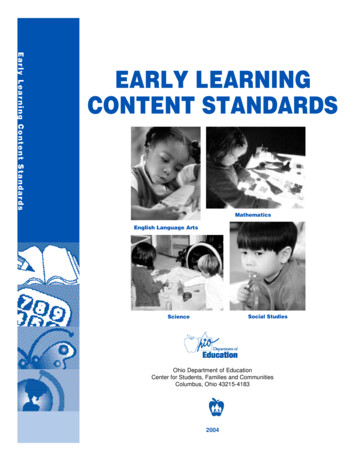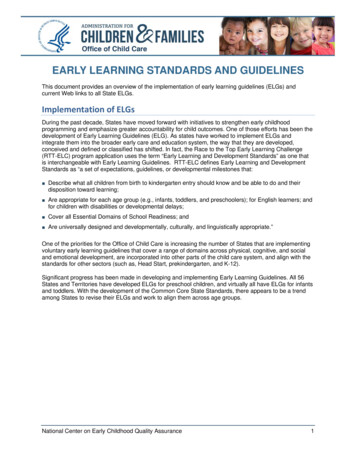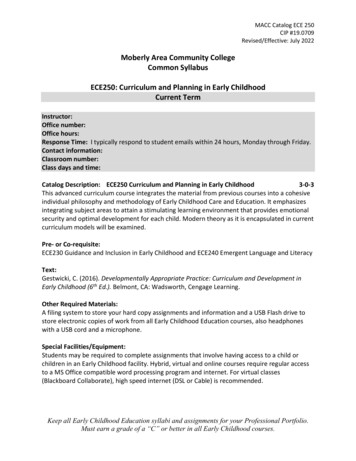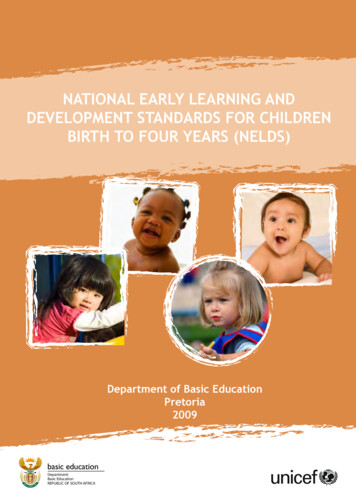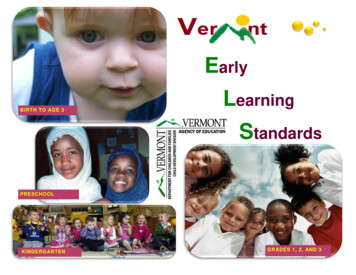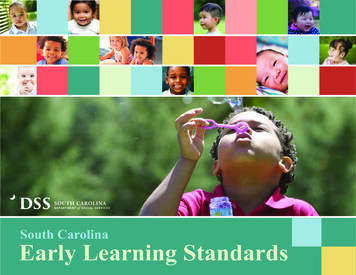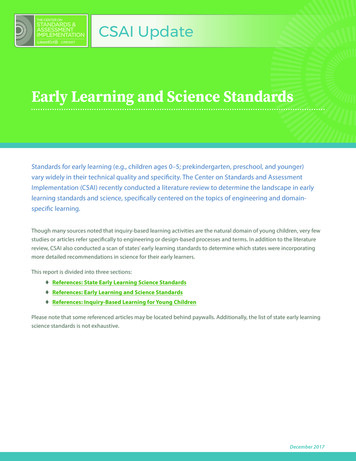
Transcription
CSAI UpdateEarly Learning and Science StandardsCSAI UpdateEarly Learning and Science StandardsStandards for early learning (e.g., children ages 0–5; prekindergarten, preschool, and younger)vary widely in their technical quality and specificity. The Center on Standards and AssessmentImplementation (CSAI) recently conducted a literature review to determine the landscape in earlylearning standards and science, specifically centered on the topics of engineering and domainspecific learning.Though many sources noted that inquiry-based learning activities are the natural domain of young children, very fewstudies or articles refer specifically to engineering or design-based processes and terms. In addition to the literaturereview, CSAI also conducted a scan of states’ early learning standards to determine which states were incorporatingmore detailed recommendations in science for their early learners.This report is divided into three sections: References: State Early Learning Science Standards References: Early Learning and Science Standards References: Inquiry-Based Learning for Young ChildrenPlease note that some referenced articles may be located behind paywalls. Additionally, the list of state early learningscience standards is not exhaustive.December 20171
CSAI UpdateEarly Learning and Science StandardsReferences—State Early Learning Science StandardsSTATESUMMARYLINKArizonaScience begins on p. 127. Published May 2013.https://cms.azed.gov/home/GetDocumentFile?id 585c4b55aadebe14288f2532CaliforniaScience begins on p. 48. Referred to as‘foundations’ rather than standards; non-bindingon LEAs or other entities. Research-baseddiscussion on developmentally appropriatecontent. Focuses on older early learners, four andfive years of age. Divided into strands (scientificinquiry, physical, life, earth). Published schoolfoundationsvol3.pdfColoradoDivided by specific content strands (physical, ce preschool kindergarten.pdfGeorgiaScience begins on p. 65. Contains indicators foreach year from 0 to 5 years old. Adopted 2013.http://www.gelds.decal.ga.gov/Documents/GELDS Resource Guide.pdfIllinoisScience begins on p. 55. A footnote indicatesthat the NGSS were consulted in revising thesestandards. Mentions engineering as part of thescientific process and includes two standardsspecific to engineering. Has some domain-specificcontent. Revised September 2013.https://www.isbe.net/Documents/earlylearning standards.pdfMarylandScience begins on p. 91. Includes domain-specificindicators for each year from 1 to 4 years old,followed by Kindergarten and Grades 1 and 2(but most domain-specific content is for the oldergroup). Adopted ppendix 2016.pdfMassachusettsPre-Kindergarten section begins on p. 25 of thefull standards document. Adopted 2016.http://www.doe.mass.edu/stem/review.htmlFull standards h/2016-04.pdfAppendix V, The Case for an IntegratedApproach in Grades ch/2016-04/AppendixV.pdfAppendix VI, Importance of Scienceand Engineering in Early ch/2016-04/AppendixVI.pdf2
CSAI UpdateEarly Learning and Science StandardsSTATESUMMARYLINKMinnesotaContains indicators for each year from 0 to 5 yearsold, with attention to “specific expectations acrossthe developmental spectrum.” Updated May d/MississippiSeparate standards documents for 3- and 4-yearolds include multiple domains in science (physical,life, science, earth, technology) and inquiry.Adopted 2013.http://www.mde.k12.ms.us/ESE/ECMontanaScience begins on p. 67. Includes indicators frominfancy through preschool, along a developmentalcontinuum (not tied to particular ages). Brokendown by Benchmarks (what the child can do),Indicators (behaviors), and Learning Opportunities(experiences to support development). ds.pdfNew HampshireScience begins on p. 30. Indicators every 9 monthsfrom birth to 3 years old, then for 4–5 year olds.Aligned to kindergarten readiness indicators.Adopted -early-learningstandards.pdfNew YorkDivided into separate documents for physical, life,and earth/space. Edited version of -science-ls.htmlOhioScience begins on p. 39. Divided into age bands(infants, young toddlers, older toddlers, pre-k).Divided into domains (inquiry, earth/space,physical, life). Most elements apply to prekindergarten only. Adopted irth-Through-Pre dards.pdf.aspxScience lg?IdcService GET FILE&dDocName MDE059810&RevisionSelectionMethod latestReleased&Rendition primary3
CSAI UpdateEarly Learning and Science StandardsSTATESUMMARYLINKRhode IslandIndicators at 9 and 18 months, then every yearuntil 5 years old. Adopted RIELDS S 082013.pdfTennesseeDocument 1 for birth through 48 months. Sciencebegins on p. 19. Adopted .htmlDocument 2 for 4-year- olds. Science begins onp. 26. Adopted 2012.Document dards/tnelds/std tneldsbirth-4yo.pdfDocument dards/tnelds/stdtnelds 4yo.pdfTexasScience begins on p. 101. End of pre-k outcomes.Divided into physical, life, and earth/space.Gives examples of child behavior and teacherinstructional strategies. Revised 2015.https://tea.texas.gov/pkg.aspx4
CSAI UpdateEarly Learning and Science StandardsReferences—Early Learning and Science StandardsThe resources in this section discuss the relationship between early childhood development and learning, as well asthe landscape of standards and other documentation for young children.REFERENCESUMMARYBlazer, C., & Miami-Dade County PublicSchools. (2012). Pre-kindergarten:Research-based recommendationsfor developing standards and factorscontributing to school readiness gaps.Information Capsule, 1201.This paper reviews the special considerations related to earlydevelopment and learning, noting the potential drawbacks ofattempting to apply standards documents to these areas. It outlinescriteria for high quality standards development. It also includes adiscussion of program standards, and reasons behind preschoolreadiness gaps.DeBruin-Parecki, A., & Slutzky, C. (2016).Exploring pre-K age 4 learning standardsand their role in early childhoodeducation: Research and policyimplications. Research Report. ETS RR-1614. ETS Research Report Series.This policy report “presents a national study of pre-K age 4 learningstandards” advancing “current knowledge regarding the purpose, history,and development of pre-K age 4 learning standards, comprehensivenessof standards documents, standards-related supports for teachers, andpre-K to kindergarten alignment.” The authors found “extensive variationacross titles, organization, terminology, and enriching materials.” Itincludes “recommendations to inform state and federal early childhoodleaders, education-focused philanthropic foundations, and others in thefield of early childhood education.”Hill, R. (2014, June 9). Should preschools“teach” science? Retrieved November07, 2017, from s-qteachqscienceThis article describes the uneven landscape of preschool standardsacross various states, with special attention on science.Neuman, S. B., & Roskos, K. (2005). The stateof state pre-kindergarten standards. EarlyChildhood Research Quarterly, 20(2), 125145. doi:10.1016/j.ecresq.2005.04.010This article argues that “coherent, quality standards and theirbenchmarks (indicators) must be solidly grounded in research, andreflect age-appropriate outcomes for young children.” It reviewskey predictors of early literacy and mathematics achievement andsummarizes recommendations from organizations that have examinedthe quality of state K-12 standards. It also examines how states areorganizing their standards and benchmarks in these content domainsin early learning. Finally, it highlights benchmarks based on thissummary of research that reflect clear, rigorous, and developmentallyappropriate expectations for young learners.Saçkes, M., Trundle, K., & Flevares, L. (2009).Using children’s literature to teachstandard-based science concepts in earlyyears. Early Childhood Education Journal,36(5), 415-422. doi:10.1007/s10643-0090304-5“This paper discusses the benefits and limitations of using children’sliterature in introducing science concepts to young children. Themanuscript also provides an overview of preschool science standardsof 12 states and presents lists of appropriate children’s literaturesuitable to use in teaching science concepts targeted in thosepreschool science standards.” The paper identifies common contentareas and themes across multiple states, but does not discuss whetherthey are developmentally appropriate.5
CSAI UpdateEarly Learning and Science StandardsReferences—Inquiry-based Learning for Young ChildrenThe resources in this section address developmentally appropriate scientific practices for young children, with themost popular topic being inquiry-based learning. Several examples of appropriate activities are discussed, withparticular attention to children’s natural affinity for exploration and its fit with the scientific process.REFERENCESUMMARYBerger, C. (n.d.). Creating an engineeringdesign process for the preschoolclassroom. Retrieved November 15,2017, from process-for-thepreschool-classroomThis article describes the Wee Engineer development process ingeneral terms, referencing an “age-appropriate engineering designprocess” that gives children the language they need to talk aboutproblem solving.Bosse, S., Jacobs, G., & Anderson, T. (2009).Science in the early years: Science in theair. Young Children, (Vol. 64, No. 5).This article published by the National Association for the Education ofYoung Children describes ways to create an environment that promotesscience and undertaking in-depth explorations. It contains a sectionon building language and scientific literacy and some discussion ofappropriate activities/concepts according to domain.Brenneman, K., Stevenson-Boyd, J., &Frede, E. C. (2009). Math and science inpreschool: Policies and practice (Issue19, Policy Brief ). Preschool Policy Brief.National Institute for Early EducationResearch. Retrieved November 7, 2017,from This policy brief published by the National Institute for Early EducationResearch “addresses the development of mathematics and scienceunderstanding in preschool children, reviews the current knowledgebase on educational practices in these domains, identifies areasthat require further study, and outlines recommendations forearly education policy in mathematics and science.” An extensivebibliography is included.Conezio, K., & French, L. (2002). Science inthe preschool classroom: Capitalizing onchildren’s fascination with the everydayworld to foster language and literacydevelopment. Young Children, (Vol 57,No. 4).This article published by the National Association for the Education ofYoung Children describes science as an approach to an activity andgives examples of activities, such as cooking, that preschool teachersmay already be comfortable incorporating into their classrooms. Theauthors draw from their experience designing an NSF- and USDOEfunded preschool science curriculum.6
CSAI UpdateEarly Learning and Science StandardsREFERENCESUMMARYDavis, M. E., Cunningham, C. M., &Lachapelle, C. p. (2017). They can’tspell “engineering” but they can do it:Designing an engineering curriculum forthe preschool classroom. Zero To Three,37(5), 4–11.“Engineering is Elementary (EiE) is a curriculum project of the Museumof Science, Boston, that promotes and supports engineering literacyand educational equity for all children. Building on the success of itsaward-winning curriculum for grades 1–5, the team has recently turnedits attention to Wee Engineer, a research-based engineering curriculumfor preschool programs. The cornerstone of the new curriculum is anage-appropriate engineering design process (EDP) that reflects bothauthentic engineering practices and the pedagogy of the preschoolclassroom. This article introduces the research and the designdecisions behind the Wee Engineer EDP, and highlights how otherdevelopmentally appropriate elements in the curriculum support earlySTEM learning.”Hachey, A., & Butler, D. (2009). Seeds in thewindow, soil in the sensory table: Scienceeducation through gardening and naturebased play. Young Children, (Vol. 64, No. 5).This article published by the National Association for the Education ofYoung Children describes nature-based play as integrating “motivatingand meaningful activity with the three elements of science education– attitude, process skills, and content,” and outlines how each of theseelements can be implemented in the preschool classroom.Hoisington, C., & Winokur, J. (2015). Gimmean “E”! Science & Children, 53(1), 44–51.This article identifies ways to organize the classroom to encouragebuilding explorations. It includes specific connection to NGSS DCIswhile noting that PEs are not appropriate for this level.Hollingsworth, H. L., & Vandermaas-Peeler,M. (2017). ‘Almost everything we doincludes inquiry’: Fostering inquiry-basedteaching and learning with preschoolteachers. Early Child Development andCare, 187(1), 152-167. doi:10.1080/03004430.2016.1154049This pair of studies focuses on preschool teachers’ efficacy in teachingscience and their inquiry-based teaching practices. A few teachersindicated knowledge of the steps of the inquiry process; after training,some were able to implement the initial steps, but often did not followthrough the entire set. Findings highlight the need for professionaldevelopment around science inquiry.Lippard, C. N., Lamm, M. H., & Riley, K.L. (2017). Engineering thinking inprekindergarten children: A systematicliterature review. Journal of EngineeringEducation, 106(3), 454–474. doi:10.1002/jee.20174This literature review notes that research regarding engineering inearly childhood is limited, yet growing along with interest in thistopic. The authors review “research regarding interactions, materialsand activities that promote prekindergarten children’s engineeringthinking, and in turn how this engineering thinking is related todevelopmental outcomes.” Out of more than 2,000 papers, 27 paperspertained to children age five or under and to engineering. Theyaddressed the following research questions: What (a) interactionsand (b) materials and activities promote prekindergarten children’sengineering thinking? What developmental outcomes are related tochildren’s engineering thinking?7
CSAI UpdateEarly Learning and Science StandardsREFERENCESUMMARYMcClure, E. R., Guernsey, L., Clements, D.H., Bales, S. N., Nichols, J., Kendall-Taylor,N., & Levine, M. H. (2017). STEM startsearly: Grounding science, technology,engineering, and math education in earlychildhood. New York: The Joan GanzCooney Center at Sesame Workshop.Retrieved November 15, 2017 from tarts-early/This report “is the culmination of a deep inquiry supported by theNational Science Foundation that aims to better understand thechallenges to and opportunities in STEM learning as documented ina review of early childhood education research, policy, and practiceand encourages collaboration between pivotal sectors to implementand sustain needed changes. The report features research by theFrameWorks Institute on some common misconceptions around earlySTEM learning, and how reframing the conversation can help thepublic overcome these often problematic ways of thinking, leading toa greater understanding of the importance of prioritizing and investingin STEM learning opportunities for all children.”Section Three notes that “the realms of early technology andengineering are less well understood” or sometimes missing in earlychildhood, but are often included in young children’s activities as lessexplicit subjects (p. 16).Appendix A, a metaanalysis of NSF awards in STEM, demonstrates thatvery few projects study the 0–4 age group, and many of those projectsfocus on Math. No projects focused on engineering exclusively for thisage group.Moomaw, S., & Davis, J. A. (2010). STEMcomes to preschool. YC Young Children,65(5), 12–18.This article focuses on an integrated approach, but does specify that“physics and engineering interest begins early” when describingactivities with pendulums and inclines.National Research Council. 2007. Takingscience to school: Learning and teachingscience in grades K-8. Washington, DC: TheNational Academies Press.https://doi.org/10.17226/11625Chapter 3 “reviews research on young children and provides anoverview of the knowledge and skills they bring to school whichprovide a foundation for learning science.” This paper suggests thata strand framework should be introduced at the kindergarten level(p. 52), and notes skills/knowledge that children should have by theend of preschool, not earlier. It covers physics, biology, psychology,substances and their transformations (chemistry), earth systems andcosmology, and scientific reasoning.Piasta, S. B., Pelatti, C. Y., & Miller, H. L.(2013). Mathematics and science learningopportunities in preschool classrooms.Early Education and Development, 013.817753This study observed and coded instruction in preschool classroomsto determine amount and type of math and science learningopportunities experienced by preschool children. Researchersobserved wide variability in the number and quality of theseopportunities, and noted that high quality math and scienceexperiences to all preschool children may require additionalprofessional development for their teachers.The authors note that the majority of science learning opportunitiesfocused on investigation and observation skills, the living world(animals, plants, humans), and the physical world (seasons, weather,magnetism, recycling/environmental issues) (p. 10).8
CSAI UpdateEarly Learning and Science StandardsREFERENCESUMMARYU.S. Department of Education. (2017, June28). Let’s Talk, Read, and Sing about STEM!Retrieved November 07, 2017, ng/talk-read-sing/index.htmlThis toolkit created by the U.S. Departments of Education and Healthand Human Services, in partnership with Too Small to Fail, features tipsheets for families, preschool teachers, and infant/toddler teachers on“easy ways to incorporate STEM concepts and vocabulary into everydayroutines, and suggestions for activities to engage young children inSTEM learning.”Worth, K. (2010). Science in early childhoodclassrooms: Content and process.Retrieved November 07, 2017, from http://ecrp.uiuc.edu/beyond/seed/worth.htmlThis conference paper from SEED (STEM in Early Education andDevelopment) “addresses the question of what the nature of scienceteaching and learning in the early childhood classroom should be. Itproposes four basic ideas: (1) doing science is a natural and criticalpart of children’s early learning; (2) children’s curiosity about thenatural world is a powerful catalyst for their work and play; (3) with theappropriate guidance, this natural curiosity and need to make sense ofthe world become the foundation for beginning to use skills of inquiryto explore basic phenomena and materials of the world surroundingchildren; and (4) this early science exploration can be a rich context inwhich children can use and develop other important skills, includingworking with one another, basic large- and small-motor control,language, and early mathematical understanding. The paper describesa structure for learning through inquiry and criteria for the selection ofappropriate content for young children. It concludes with a discussionof implications for the classroom, focusing on child-centeredcurriculum, the role of materials, the use of time and space, the keyrole of discussion and representation, and the teacher’s role.” The paperincludes a diagram of the inquiry process of young children.(continued)9
CSAI UpdateEarly Learning and Science StandardsREFERENCESUMMARYWorth, K., & Grollman, S. H. (2009). Worms,shadows, and whirlpools: Science in theearly childhood classroom. RetrievedNovember 7, 2017, from his book offers guidance in integrating inquiry-based science intothe early childhood curriculum, focusing on content and providingexamples of the work of children and teachers from a variety of earlychildhood settings, including Head Start, kindergarten, day care,and preschool programs. Part 1 of the book provides an overview ofimportant characteristics of a high-quality science program for childrenages 3 to 5 and some of the important tasks teachers perform tomake it a reality. Part 2 concerns the content of science education foryoung children and begins with a chapter on inquiry, describing theimportant skills, ways of thinking, and attitudes that are at the heart ofscientific understanding and at the core of an effective early childhoodscience program. Chapters follow on life, physical, earth, and spacesciences. Each of these four chapters begins with an overview of thescience concepts and ideas that should guide the development ofscience curriculum for young children, followed by composite storiesdrawn from early childhood classrooms that illustrate critical aspectsof science content and science teaching. Each story is accompaniedby a commentary highlighting particular teaching strategies andchild learning. Part 3 of the book includes questions that practitionersfrequently ask about inquiry-based science in early childhoodclassrooms, including the relative importance of science content versusscience inquiry skills, the role of child-initiated activity and children’splay, and the place of science in a curriculum focused on literacy,mathematics, and social skills.”This book contains chapters devoted to separate domains (inquiry, life,physical, earth/space).CSAI Update is produced by the The Center on Standards and AssessmentImplementation (CSAI). CSAI, a collaboration between WestEd and CRESST, providesstate education agencies (SEAs) and Regional Comprehensive Centers (RCCs) withresearch support, technical assistance, tools, and other resources to help informdecisions about standards, assessment, and accountability. Visit www.csai-online.org formore information.This document was produced under prime award #S283B050022A between the U.S. Department of Education and WestEd. The findings and opinionsexpressed herein are those of the author(s) and do not reflect the positions or policies of the U.S. Department of Education.WestEd is a nonpartisan, nonprofit research, development, and service agency that partners witheducation and other communities throughout the United States and abroad to promote excellence,achieve equity, and improve learning for children, youth, and adults. WestEd has more than a dozenoffices nationwide, from Massachusetts, Vermont and Georgia, to Illinois, Arizona and California,with headquarters in San Francisco.For more information, visit WestEd.org; call 415.565.3000 or, toll-free, (877) 4-WestEd; or write:WestEd / 730 Harrison Street / San Francisco, CA 94107-1242.10
References: State Early Learning Science Standards References: Early Learning and Science Standards References: Inquiry-Based Learning for Young Children Please note that some referenced articles may be located behind paywalls. Additionally, the list of state early learning science standards is not exhaustive. December 2017
